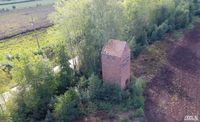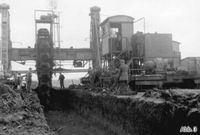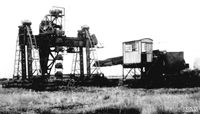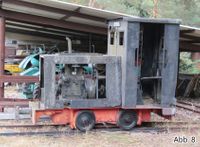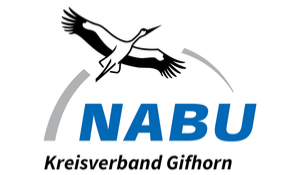The Gigant
A giant too big for the Great Moor
The E. LIEDTKE peat works owned the largest electric peat excavator in Europe. It was known as the “Giant of the Moor” (Figs. 3-5). The manufacturer, the company Hesepe, christened the machine the Mammoth. It was employed along the Heudamm in Stüde from 1946 until 1960.
The transformer station in front of you (Fig. 2) is a reminder of this time. In the early years after the Second World War, the peat excavator was only allowed to be put into operation at night. It needed so much energy that the whole energy supply network would otherwise have collapsed.
For the Great Moor near Gifhorn, the Gigant was too big and proved to be a poor investment. Unlike the moors in the Emsland district, our moor has been characterised by periods of drought over the last 6,000 to 7,500 years. Trees were able to grow in these periods. There roots (Fig. 6) were hardly able to rot. All too frequently, the extraction of the peat had to be interrupted to remove roots.
Up to 200 persons were employed by the E. LIEDTKE peat works (Fig. 7).
Wilhelm Dietz, the last proprietor of the company, which closed its doors for good in 2005, donated the small engine (Fig 8) that you can see at the entrance to our museum to the Friends of the Great Moor. After its active time in the moor, the engine stood idly in front of the Findorff School in Neudorf-Platendorf. The headmaster at the time, Ulrich Stenzel, together with Heinrich Wulfes, had recovered the engine from the moor. The engine was restored by the Friends of the Great Moor. A total of six engines of this kind were in operation at the E. LIEDTKE peat works.
Links to other stations in the museum - in English language:
<1> <2> <3> <4> <5> <6> <7> <8> <9> <10> <11> <12> <13> <14> <15> <16> <17> <18> <19> <20> <21> <22> <23>
